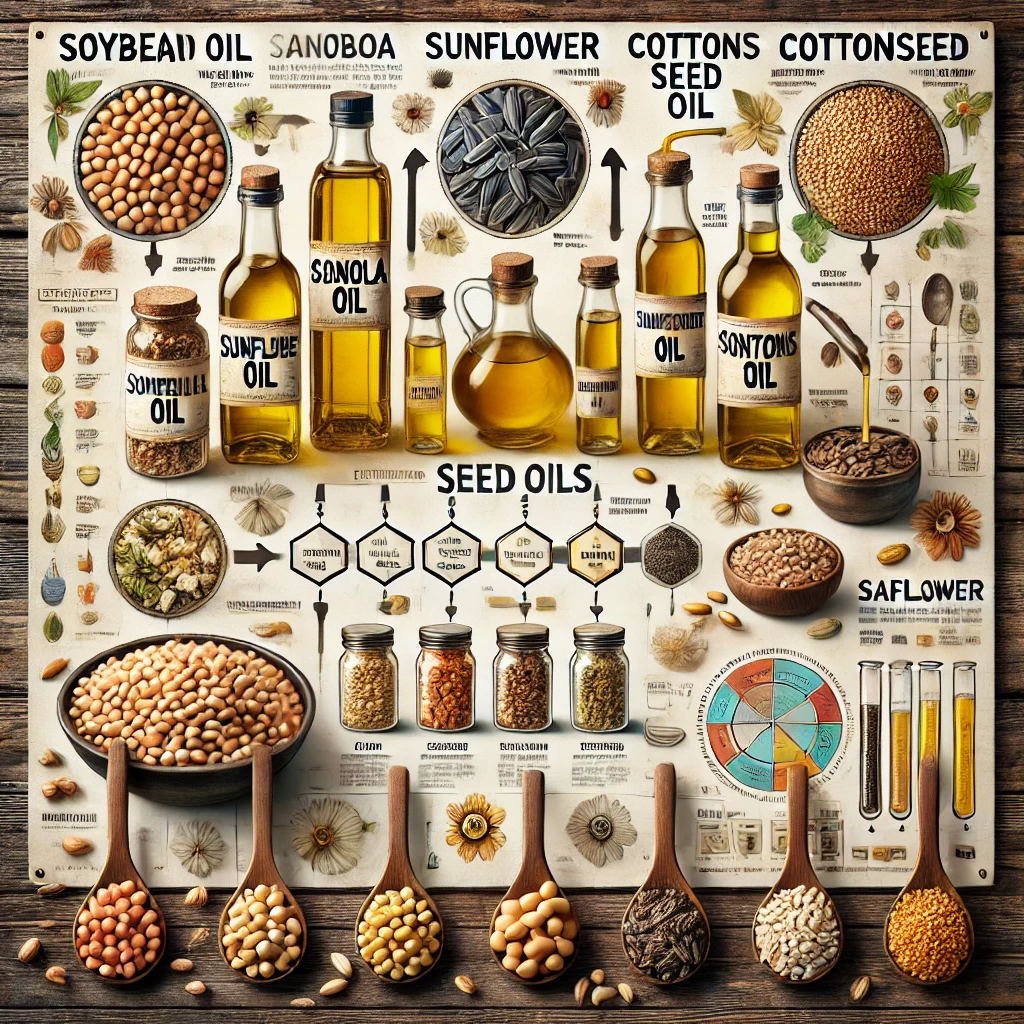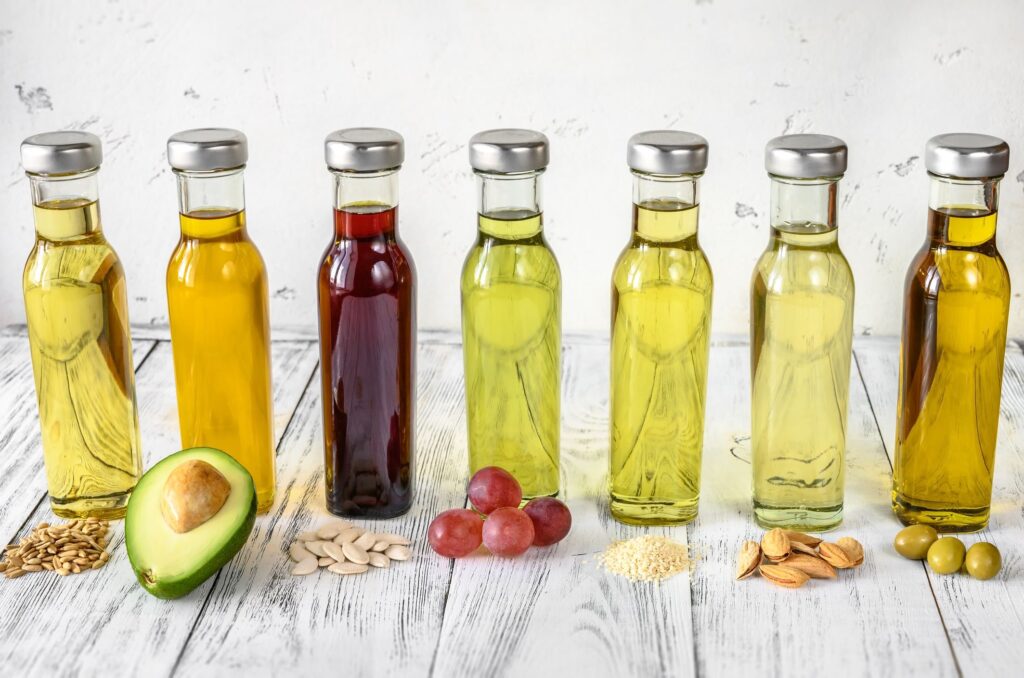Seed oils are not good for us, and we can see what happens to our health when we eat a lot of processed foods. Next time you’re at the grocery store, take a look at the ingredients on food labels—you’ll notice that tons of foods have seed oils (and other not-so-good ingredients). It starts with an understanding if seed oils are bad for you.
By learning more about seed oils and processed foods, you’ll start to understand how they show up in our lives and how they can affect us. Plus, you’ll pick up tips on making healthier choices so you can live your best, healthiest life!
Unpacking Seed Oils
To have an understanding if seed oils are bad for you, it’s essential to first define what seed oils are and explore the common types available.
What Are Seed Oils?
Seed oils come from the seeds of different plants. People use them a lot for cooking, making food, and even in some beauty products. These oils have things like fats, vitamins, and antioxidants, which can make them nutritious. But the way these oils are taken out and cleaned up can change how healthy they are.
Seed oils have a lot of a type of fat called polyunsaturated fat, especially omega-6 fatty acids. Our bodies need omega-6, but it’s important to balance it with omega-3 fatty acids to stay healthy. For more about how these balances affect health, see our article on seed oils and inflammation.
Common Types of Seed Oils
There are several types of seed oils, each with unique characteristics and uses. Here are a few of the most common:
| Seed Oil Type | Source | Common Uses | Omega-6 Content (%) |
|---|---|---|---|
| Sunflower Oil | Sunflower Seeds | Cooking, Salad Dressings | 65 – 75 |
| Soybean Oil | Soybeans | Cooking, Processed Foods | 51 |
| Canola Oil | Rapeseed | Cooking, Baking | 20 |
| Safflower Oil | Safflower Seeds | Cooking, Salad Dressings | 78 |
| Grapeseed Oil | Grape Seeds | Cooking, Salad Dressings | 68 |

Each type of seed oil is a little different. These differences can change how the oil tastes, how well it works in cooking, and even how it might affect your health. If you want to learn more about the possible risks or side effects of using seed oils, check out our pages on seed oil dangers and seed oil side effects.
Learning about common seed oils can help you understand why some people are concerned about using them. It’s also important to know how to balance these oils with others, like olive oil, which we explain more in our article on seed oils and olive oil.
The Debate: Are Seed Oils Bad for You?
There’s a lot of talk about seed oils and whether they’re good or bad for you. Let’s look at both sides to understand more.
Health Benefits of Seed Oils
Some people say that seed oils can be good for us because they have certain healthy fats and vitamins. Here are some reasons why:
- Full of Good Fats: Seed oils have special fats called polyunsaturated fats, like omega-3 and omega-6. Our bodies need these fats to keep our hearts and brains working well.
- Vitamins and Protectors (Antioxidants): Some seed oils, like sunflower and flaxseed oil, have Vitamin E and antioxidants. These can help protect our cells from getting damaged.
- May Be Good for Your Heart: Some research says that the fats in seed oils might help lower “bad” cholesterol, which could reduce the risk of heart problems.
| Seed OilType | Omega-3 (%) | Omega-6 (%) |
|---|---|---|
| Flaxseed Oil | 57% | 16% |
| Sunflower Oil | 0% | 68% |
| Soybean Oil | 7% | 54% |
For a detailed understanding of the fatty acid composition, you might want to check out seed oils and olive oil.
Potential Health Concerns
On the other hand, there are some worries about the possible bad effects of eating too many seed oils:
- Too Much Omega-6: Seed oils have a lot of omega-6 fatty acids, which can cause problems if you don’t have enough omega-3s. Too much omega-6 and not enough omega-3 can lead to inflammation, which isn’t good for your body. This imbalance is a key point discussed in seed oils and inflammation.
- Processing and Additives: The way seed oils are made can change how healthy they are. Some highly processed seed oils can have harmful additives, and they might lose some of the good nutrients during processing.
- Possible Health Risks: Some studies show that eating a lot of certain seed oils might be linked to health problems, like issues with metabolism and heart disease. More on this can be found in our article on seed oil dangers.
| Concern Type | Description |
|---|---|
| Omega-6 Imbalance | Can lead to inflammatory responses in the body |
| Processing | Loss of nutrients and addition of harmful substances |
| Potential Health Risks | Linked to metabolic and cardiovascular issues |
Incorporating these insights helps me make informed choices about consuming seed oils. For a broader perspective on their side effects, read seed oil side effects.
Understanding the Science Behind Seed Oils
To make an informed choice about seed oils, it’s important to understand the science behind them. This includes looking at the types of fatty acids in these oils and how they impact inflammation and overall health.

Omega-3 vs. Omega-6 Fatty Acids
Seed oils are rich in polyunsaturated fats, including both omega-3 and omega-6 fatty acids. These fatty acids play essential roles in the body, but maintaining the right balance between them is crucial for health.
| Fatty Acid | Common Sources | Health Impact |
|---|---|---|
| Omega-3 | Fish, Flaxseed, Chia Seeds | Reduces inflammation, supports heart health |
| Omega-6 | Soybean Oil, Corn Oil, Safflower Oil | Can promote inflammation if consumed in excess |
Omega-3 fatty acids have anti-inflammatory properties and provide numerous health benefits. On the other hand, omega-6 fatty acids can contribute to inflammation if consumed in large amounts without sufficient omega-3 intake. The ideal balance between omega-3 and omega-6 fatty acids should generally be a ratio of 1:1 to 1:4.
Many seed oils, like soybean oil and corn oil, are particularly high in omega-6 fatty acids. This can disrupt the balance if not countered with enough omega-3 fatty acids from other dietary sources.
Influence on Inflammation and Health
Inflammation is a natural process in the body, but chronic inflammation can lead to various health issues. The type and balance of fatty acids consumed can significantly influence levels of inflammation.
Here’s how different fatty acids affect inflammation:
| Fatty Acid | Impact on Inflammation |
|---|---|
| Omega-3 | Lowers inflammation |
| Omega-6 | Raises inflammation (when excessive) |
Eating a lot of omega-6 fats, which are in many processed foods and seed oils, can cause inflammation in our bodies if we don’t balance it with enough omega-3 fats. This is important because too much inflammation can lead to health problems like heart disease, arthritis, and even some types of cancer. For more about how seed oils might cause inflammation, check out our article on seed oils and inflammation.
When it comes to seed oils, it’s important to balance omega-6 and omega-3 fats. You can get omega-3s from foods like flaxseeds and fish, and it’s a good idea to limit how much omega-6-rich seed oil you eat to stay healthy. For more information on the risks, see our page on the side effects of seed oils.
By learning this, you can make better choices about using seed oils in your diet and help protect your health.
Making Informed Choices
When it comes to understanding whether seed oils are beneficial or harmful, informed choices are paramount. Here is how you can incorporate seed oils into your diet wisely and balance them with other healthy fats.
Incorporating Seed Oils Wisely
Keeping a balanced diet means being careful with how much seed oil you use. Seed oils have something called omega-6, which our bodies need, but too much can mess up the balance with another important nutrient called omega-3.

Here is How to Use Seed Oils in a Smart Way:
- Use Only a Little: Try not to use too much seed oil. Eating a lot of it might cause health problems. Learn more about the potential seed oil dangers.
- Cook at the Right Temperatures: Some seed oils don’t do well with high heat. If they get too hot, they can release stuff that’s bad for you.
- Balance with Omega-3 Foods: To keep things balanced, eat foods with omega-3, like fish, flaxseeds, and walnuts. This helps keep the omega-6 and omega-3 levels just right.
Balancing Seed Oils with Other Healthy Fats
Getting the right balance of omega-3 and omega-6 fats is important to lower inflammation (swelling) in the body and stay healthy. Here’s how you can do it:
| Fat Type | Source | Omega-3 (mg) | Omega-6 (mg) |
|---|---|---|---|
| Flaxseed Oil | Flaxseeds | 7196 | 1714 |
| Fish Oil | Salmon | 2525 | 0 |
| Olive Oil | Olives | 81 | 1310 |
| Sunflower Oil | Sunflower Seeds | 0 | 9000 |
- Add Omega-3 Foods to Your Diet: Foods like fish, flaxseed oil, and walnuts have a lot of omega-3 fatty acids. Omega-3s help balance out the omega-6 fatty acids found in many other oils. Fish oil, for example, has mostly omega-3s, which can help reduce the effects of having too much omega-6.
- Choose Cooking Oils with Better Balance: Some oils, like olive oil, have a healthier mix of omega-3 and omega-6. This makes them a better choice than some other oils. You can learn more about how seed oils and olive oil compare.
- Watch Your Omega-6 Intake: Pay attention to how much omega-6 you get from seed oils. If it seems high, try to add more omega-3 foods to your meals.
Using these ideas, you can enjoy seed oils in a healthier way. Understanding this balance can help avoid possible side effects from seed oils and make better choices for your health.

